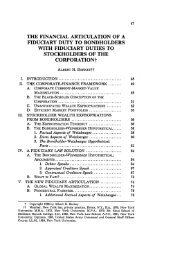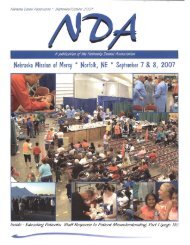Rocky Mountain Spotted Fever - United si^ef978/«n?e^ &/
Rocky Mountain Spotted Fever - United si^ef978/«n?e^ &/
Rocky Mountain Spotted Fever - United si^ef978/«n?e^ &/
You also want an ePaper? Increase the reach of your titles
YUMPU automatically turns print PDFs into web optimized ePapers that Google loves.
April 27,1979<br />
Endotoxic Reactions Associated with<br />
the Reuse of Cardiac Catheters — Michigan<br />
Two outbreaks of endotoxic reactions (fever, chills, and occasionally hypotension)<br />
have recently been reported in Michigan hospitals; at least 42 patients undergoing cardiac<br />
catheterization were involved. As in a similar outbreak in Massachusetts (7), reusable<br />
intravascular catheters were implicated.<br />
In 1 hospital, 32 patients in 1977 experienced pyrogenic reactions during catheteri<br />
zation. The catheters, although microbiologically sterile when used, were found, upon<br />
investigation, to be contaminated with endotoxin. Before the outbreak, cardiac catheters<br />
had been washed, rinsed with distilled water, wrapped, and, within 4 days, sterilized<br />
with ethylene dioxide.<br />
In April 1977, during an investigation of the outbreak, a washed, wrapped cardiac<br />
catheter, stored at 28 C for 72 hours, was opened, flushed with sterile, distilled water,<br />
and cultured. An aliquot of the water, after flushing, contained 700,000 colony-forming<br />
units (CFU)/ml of Acinetobacter calcoaceticus var. anitratus. The distilled water had been<br />
obtained from a holding tank in the central supply room, from which samples yielded<br />
3,500 CFU/ml A. calcoaceticus of the same variety and biotype.<br />
When the sterilized catheters were cultured, they were found to be negative for bac<br />
teria, by Limulus Amebocyte Lysate (LAL) assay. The eluates induced fever and hypo<br />
tension when infused intravenously into rabbits.<br />
Following this investigation, reusable cardiac catheters were immediately washed,<br />
rinsed, and sterilized in a single, daily operation. No subsequent endotoxic reactions have<br />
occurred.<br />
In the second outbreak, pyrogenic reactions had been observed periodically during<br />
cardiac catheterization since the unit opened in 1974. But in July and August 1978,<br />
10 of 135 patients experienced a reaction. Investigation then revealed that a combi<br />
nation of disposable and used, nondisposable catheters was employed for catheterizing<br />
most patients. Pseudomonas species, Escherichia coli, and Enterobacter species were<br />
cultured from the soap in which the catheters soaked after use. Despite sterilization<br />
with ethylene oxide, catheters yielded endotoxin when flushed with pyrogen-free saline.<br />
As in the previous investigation, the eluate produced pyrogenic reactions in rabbits.<br />
For 2 months after the outbreak, this hospital employed the additional step of ultra-<br />
sonically cleaning catheters after they had been used. Nevertheless, at least 2 more<br />
reactions occurred. Of 17 nondisposable catheters tested, 5 revealed endotoxin by LAL<br />
testing. Since November, only disposable catheters have been used, and no reactions have<br />
occurred among more than 380 patients.<br />
Reported by WJ Brown, PhD, M Fowler, MD, C Friedman, MPH, S Ganguly, MD, B Gatmaitan, MD,<br />
AM Lerner, MD, MP Reyes, MD, Hutzel Hospital, Detroit; LR Davis, LF Herrera, MD, J Kloepfer, MD,<br />
I Leader, P Tusnell, Ingham Medical Center, Lansing; DO Huggett, PhD, NS Hayner, MD, State Epide<br />
miologist, JA Weber, MPH, Michigan State Department of Public Health; Hospital Infections Br, Bac<br />
terial Diseases Div, Bur of Epidemiology, CDC.<br />
Reference<br />
1. MMWR 28:25, 1979<br />
Penicillinase-Producing Neisseria gonorrhoeae — Alaska<br />
Alaska's second and third cases of penicillinase-producing Neisseria gonorrhoeae<br />
(PPNG) were identified in December 1978.<br />
On December 14, a 60-year-old man presented to an Anchorage Health Department<br />
venereal disease clinic, giving a history of a recent urethra! discharge. Examination re-








